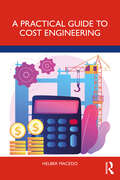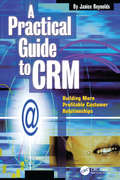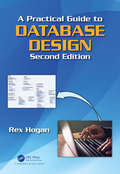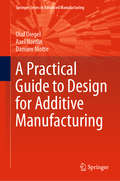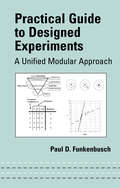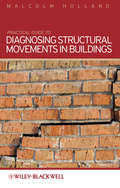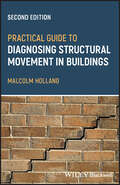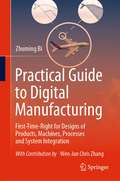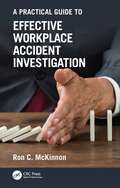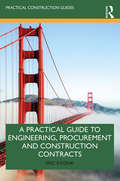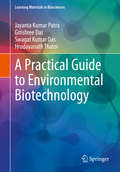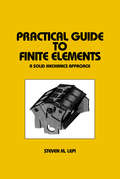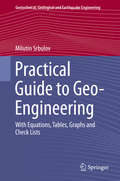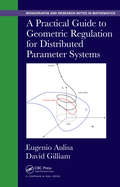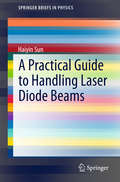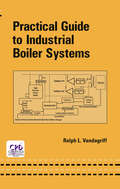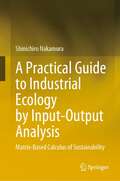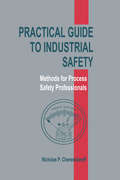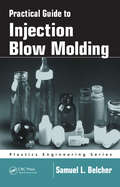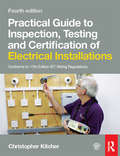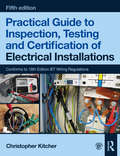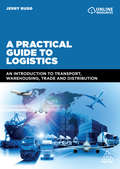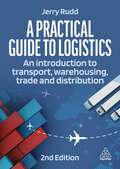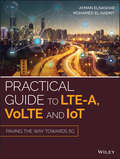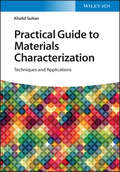- Table View
- List View
A Practical Guide to Cost Engineering
by Helber MacedoA Practical Guide to Cost Engineering aims to show you how to work as a cost engineer out in the real world.Written by an experienced cost engineer and training program developer, this book introduces the practical side of cost management (cost estimation, cost reduction, and cost control) through real cases and realistic examples from a diverse range of engineering-based projects. With examples from nuclear, oil and gas, and renewable energy sectors, the book introduces and demonstrates the activities of the cost engineer throughout a project life cycle. The content is divided into logical sections covering basic concepts, cost estimation, cost control, economic feasibility, sustainability, and more, and the chapters are packed full of features such as definitions, formulas, exercises, and examples. The focus is on providing a practical approach where the reader can first understand a concept and then apply it using an Excel tool developed by the author which allows the reader to simulate different scenarios and results.The simple approach focusing on essential information backed up by practical scenarios presented in this book allows cost engineers and related professionals to execute and understand their activities, develop their professional skills, and even develop in-house training programs. A Practical Guide to Cost Engineering is accompanied by online resources, accessible via the Routledge Resource Centre wesbite.
A Practical Guide to CRM: Building More Profitable Customer Relationships
by Janice ReynoldsIn today's global economy the customer has more and better choices than ever before, bringing on one of the biggest challenges the business community faces today - customer loyalty and retention. To thrive in today's customer-driven economy a company need
A Practical Guide to Database Design (Second Edition)
by Rex HoganFully updated and expanded from the previous edition, A Practical Guide to Database Design, Second Edition, is intended for those involved in the design or development of a database system or application. It begins by focusing on how to create a logical data model where data is stored "where it belongs." Next, data usage is reviewed to transform the logical model into a physical data model that will satisfy user performance requirements. Finally, it describes how to use various software tools to create user interfaces to review and update data in a database. Organized into 11 chapters, the book begins with an overview of the functionality of database management systems and how they guarantee the accuracy and availability of data. It then describes how to define and normalize data requirements to create a logical data model, then map them into an initial solution for a physical database. The book next presents how to use an industry-leading data modeling tool to define and manage logical and physical data models. After that, it describes how to implement a physical database using either Microsoft Access or SQL Server and how to use Microsoft Access to create windows interfaces to query or update data in tables. The last part of the book reviews software tools and explores the design and implementation of a database using as an example a much more complex data environment for a University. The book ends with a description of how to use PHP to build a web-based interface to review and update data in a database.
A Practical Guide to Design for Additive Manufacturing (Springer Series in Advanced Manufacturing)
by Olaf Diegel Axel Nordin Damien MotteThis book provides a wealth of practical guidance on how to design parts to gain the maximum benefit from what additive manufacturing (AM) can offer. It begins by describing the main AM technologies and their respective advantages and disadvantages. It then examines strategic considerations in the context of designing for additive manufacturing (DfAM), such as designing to avoid anisotropy, designing to minimize print time, and post-processing, before discussing the economics of AM. The following chapters dive deeper into computational tools for design analysis and the optimization of AM parts, part consolidation, and tooling applications. They are followed by an in-depth chapter on designing for polymer AM and applicable design guidelines, and a chapter on designing for metal AM and its corresponding design guidelines. These chapters also address health and safety, certification and quality aspects. A dedicated chapter covers the multiple post-processing methods for AM, offering the reader practical guidance on how to get their parts from the AM machine into a shape that is ready to use. The book’s final chapter outlines future applications of AM. The main benefit of the book is its highly practical approach: it provides directly applicable, “hands-on” information and insights to help readers adopt AM in their industry
Practical Guide To Designed Experiments: A Unified Modular Approach (Mechanical Engineering)
by Paul D. FunkenbuschMany engineers and scientists have receive little or no training in designed experiments, and any courses that are available tend to be either abstract and divorced from practical considerations or strictly practical-lacking the rigor and depth necessary for true, long-term understanding.Practical Guide to Designed Experiments: A Unified Mo
Practical Guide to Diagnosing Structural Movement in Buildings
by Malcolm Holland"What's the Crack?" When cracking is observed in a building the most common reaction is that it must be the foundations and that it must be serious. Many surveyors are nervous about diagnosing cracks. This is understandable, as the interpretation of cracks can be difficult to teach, with university courses providing little or no time for field experience. Yet by understanding one straightforward principle the majority of cracks can be diagnosed in just a few minutes. Linking this with a good knowledge of construction techniques, the factors that distort cracking patterns and the key features of common causes of cracking, almost all cracks can be diagnosed quickly and with confidence. Practical Guide to Diagnosing Structural Movement in Buildings provides a methodology by which cracks and movement in buildings can be diagnosed. Written in four parts, part one describes the key principles of movement and cracking. Parts two and three describe the main features of common forms of movement and the associated crack patterns. Part two covers causes other than ground or foundation movement and part three covers movement caused by ground or foundation problems. Part four briefly describes the techniques used to arrest further movement or repair damage cause by movement. Primarily intended for the relatively inexperienced surveyor or engineer and undergraduate students of surveying as a practical guide for use on site, it focuses on identification and diagnosis. It will not only help in correctly diagnosing the problem but it will also demonstrate a methodical approach to show and record how the diagnosis was reached – critical when giving advice to third parties. "What's the crack?" - In the vast majority of cases it's not foundation related and in most cases it's not indicating a serious defect.
Practical Guide to Diagnosing Structural Movement in Buildings
by Malcolm HollandPRACTICAL GUIDE TO DIAGNOSING STRUCTURAL MOVEMENT IN BUILDINGS Concise and readable practitioner focused guide to diagnosing the causes of cracks and movement in buildings The expanded and updated Second Edition of Practical Guide to Diagnosing Structural Movement in Buildings shows how movement can manifest as cracking in the building fabric and provides a rigorous, structured approach to understanding the evidence to ensure the surveyor can confidently diagnose the cause and impact of any structural movement they encounter. The book is written in four parts, with part one describing the key principles of movement and cracking. Parts two and three describe the main features of common forms of movement and the associated crack patterns, with part two covering causes other than ground or foundation movement and part three covering movement caused by ground or foundations. Part four briefly describes the techniques used to arrest further movement or repair damage caused by movement. Topics covered in Practical Guide to Diagnosing Structural Movement in Buildings include: First principles, including crack patterns and cracks, rotational movement, weak routes, load distribution, and movement and orientation Expansion cracking, cavity wall tie corrosion, roof spread, springing from deflected beams, and overloaded floors and beams Clay heave, uneven loading, eccentric loading on foundations, drains and drain trenches, differential foundation movement, and load concentrations on foundations Repair methods, including stitching in brickwork, reinforcing brick mortar joints, tie bars, restraint straps, underpinning, grouting, and root barriers Primarily intended for the relatively inexperienced surveyor or engineer, as well as undergraduate students, Practical Guide to Diagnosing Structural Movement in Buildings focuses on identification and diagnosis, helping to correctly diagnose problems while also demonstrating a methodical approach to show and record how the diagnosis was reached, which is critical in client satisfaction.
Practical Guide to Digital Manufacturing: First-Time-Right for Design of Products, Machines, Processes and System Integration
by Zhuming BiThis book covers the subject of digital manufacturing. It provides a practical guide for readers on using computer aided design (CAD), computer aided engineering (CAE) and computer aided manufacturing (CAM) and other computer assistive tools for the design of products, machines, processes and system integrations through the case studies of engineering projects. The book introduces a thorough theoretical foundation and discussion of the historical development, and enabling technologies of digital manufacturing. It also covers a broad range of computer aided tools for a variety of applications including: geometric modelling;assembly modelling;motion simulation;finite element analysis;manufacturing process simulation;machining programming;product data management; and,product lifecycle management. Practical Guide to Digital Manufacturing uses many real-world case studies to illustrate the discussed applications, making it easily readable for undergraduate and graduate students, as well as engineers with the needs of computer-aided design and manufacturing knowledge and skills.
A Practical Guide to Effective Workplace Accident Investigation
by Ron C. McKinnonThis book explains how accidents and high potential near-miss incidents are caused, and how to eliminate recurrences by effective accident investigation methods. It shows how to conduct an immediate and root cause analysis so that remedial measures can be taken to prevent a recurrence of similar events. The book shows how to apply the Logical Sequence Accident Investigation Method in the case studies presented. The book: Provides a practical guide to accident causes, investigation and prevention. Explains immediate and root causes in detail. Gives a number of problem-solving methods for the accident investigator to use. Introduces the Logical Sequence Accident Investigation Method. Provides a practical accident investigation evaluation system. The book discusses important topics including hazard identification and risk assessment, workplace health and safety, accident causation and prevention theories, the updated accident domino sequence, as well as safety management system standards and controls. The text is primarily written for professionals and graduate students in the fields of occupational health and safety, ergonomics and human factors engineering.
A Practical Guide to Engineering, Procurement and Construction Contracts (Practical Construction Guides)
by Eric EgginkThis book is a step-by-step practical guide on how to achieve successful projects in EPC/turnkey contracting and construction. Mapping out the shape of a project, the book spells out where things often go wrong, where and why disputes arise, and how to avoid conflicts. It is a key reference point for all involved in the contract, making it attractive to legal practitioners, construction industry professionals, and government officials involved with these projects.
A Practical Guide to Environmental Biotechnology (Learning Materials in Biosciences)
by Jayanta Kumar Patra Gitishree Das Swagat Kumar Das Hrudayanath ThatoiThis textbook provides practical guidelines on conducting experiments across the entire spectrum of environmental biotechnology. It opens with general information on laboratory safety, rules and regulations, as well as a description of various equipment commonly used in environmental laboratories. It then discusses in detail the major experiments in basic and advanced environmental studies, including the analysis of water and soil samples; the isolation, culture, and biochemical characterization of microbes; and plant tissue culture techniques and nutrient analyses. Each chapter features detailed method sections and easy-to-follow protocols, and offers guidance on calculations and formulas, as well as illustrative flow charts to assist with troubleshooting for each experiment. Given its scope, the book is an invaluable aid for laboratory researchers studying environmental biotechnology, and a rich source of information and advice for advanced undergraduates and graduates in the fields of environmental science and biotechnology.
Practical Guide to Finite Elements: A Solid Mechanics Approach
by Steven LepiAssuming only basic knowledge of mathematics and engineering mechanics, this lucid reference introduces the fundamentals of finite element theory using easy-to-understand terms and simple problems-systematically grounding the practitioner in the basic principles then suggesting applications to more general cases.Furnishes a wealth of practical insights drawn from the extensive experience of a specialist in the field!Generously illustrated with over 200 detailed drawings to clarify discussions and containing key literature citations for more in-depth study of particular topics, this clearly written resource is an exceptional guide for mechanical, civil, aeronautic, automotive, electrical and electronics, and design engineers; engineering managers; and upper-level undergraduate, graduate, and continuing-education students in these disciplines.
Practical Guide to Geo-Engineering
by Milutin SrbulovThis handy reference manual puts a wealth of ready-to-use information, data, and practical procedures within immediate reach of geo-engineers and technicians, whether they be in the field or office. It assembles and organizes the most-needed set of equations, tables, graphs and check-lists on six major subfields of geo-engineering: investigations, testing, properties, hazards, structures and works. This practical reference for the professional and others interested in the subject of ground engineering skips lengthy definitions to highlight best practice and methods proven most effective. While reflecting codes and standards, it also fills the gaps with non-standard approaches when existing ones are skimpy on practical details or agreement. Enhanced by 146 illustrations and 83 tables, the Practical Guide to Geo-Engineering points users to supporting information and data through its extensive reference list. Audience: This book is of interest to everyone involved in practical geo-engineering.
A Practical Guide to Geometric Regulation for Distributed Parameter Systems (Chapman & Hall/CRC Monographs and Research Notes in Mathematics)
by Eugenio Aulisa David GilliamA Practical Guide to Geometric Regulation for Distributed Parameter Systems provides an introduction to geometric control design methodologies for asymptotic tracking and disturbance rejection of infinite-dimensional systems. The book also introduces several new control algorithms inspired by geometric invariance and asymptotic attraction for a wid
A Practical Guide to Handling Laser Diode Beams (SpringerBriefs in Physics)
by Haiyin SunThis book offers the reader a practical guide to the control and characterization of laser diode beams. Laser diodes are the most widely used lasers, accounting for 50% of the global laser market. Correct handling of laser diode beams is the key to the successful use of laser diodes, and this requires an in-depth understanding of their unique properties. Following a short introduction to the working principles of laser diodes, the book describes the basics of laser diode beams and beam propagation, including Zemax modeling of a Gaussian beam propagating through a lens. The core of the book is concerned with laser diode beam manipulations: collimating and focusing, circularization and astigmatism correction, coupling into a single mode optical fiber, diffractive optics and beam shaping, and manipulation of multi transverse mode beams. The final chapter of the book covers beam characterization methods, describing the measurement of spatial and spectral properties, including wavelength and linewidth measurement techniques. The book is a significantly revised and expanded version of the title Laser Diode Beam Basics, Manipulations and Characterizations by the same author. New topics introduced in this volume include: laser diode types and working principles, non-paraxial Gaussian beam, Zemax modeling, numerical analysis of a laser diode beam, spectral property characterization methods, and power and energy characterization techniques. The book approaches the subject in a practical way with mathematical content kept to the minimum level required, making the book a convenient reference for laser diode users.
Practical Guide to Industrial Boiler Systems
by Ralph VandagriffThis volume covers the fundamentals of boiler systems and gathers hard-to-find facts and observations for designing, constructing and operating industrial power plants in the United States and overseas. It contains formulas and spreadsheets outlining combustion points of natural gas, oil and solid fuel beds. It also includes a boiler operator's tra
A Practical Guide to Industrial Ecology by Input-Output Analysis: Matrix-Based Calculus of Sustainability
by Shinichiro NakamuraThis book addresses the growing need for a standard textbook on input-output analysis (IO) within the context of industrial ecology (IE). IE is a discipline dedicated to providing system-wide, quantitative, and science-based solutions for sustainable development challenges, and its global importance has been rapidly increasing. The primary analytical tools of IE are life-cycle assessment (LCA) and material flow analysis (MFA). IO has been widely utilized for LCA since the late 1990s and is increasingly being applied to MFA as well. This trend is being driven by the greater availability and application of global IO data, which now includes an ever-expanding number of countries and regions. Despite the presence of excellent textbooks on IO and IE individually, there is a lack of resources that integrate these two fields. This book seeks to fill that gap by focusing on the practical application of IO to IE, specifically in the context of LCA and MFA. By combining these methodologies, readers can gain valuable insights into sustainable development issues and contribute to more effective solutions in the field of IE.
Practical Guide to Industrial Safety: Methods for Process Safety Professionals
by Nicholas P. CheremisinoffA practical guide to industrial safety. It seeks to assist specialists in managing operations in industrial settings, including high-risk personal exposure such as inhalation hazards and direct chemical contact. It covers hazards in the chemical process industries, inhalation hazards in refineries, indoor air quality management, personal protective
Practical Guide To Injection Blow Molding (Plastics Engineering #71)
by Samuel L. BelcherTaking a straight-forward approach, the Practical Guide to Injection Blow Molding explores the entire industry from conception, design, costing, tooling, and machinery, to trouble-shooting, testing, and daily production. With information for both the novice investor and the plastic industry expert, this concise text is reinforced with pictures, charts, and figures. The author, a highly knowledgeable industry insider, and a member ofThe Plastics Hall of Fame, discusses the history of the industry, as well as its daily workings. He instructs in product and tooling design, as well as material and machine selection, explaining advantages and disadvantages, elaborating on efficiencies that can be realized.
Practical Guide to Inspection, Testing and Certification of Electrical Installations
by Christopher KitcherFull coverage of testing and inspection methods, helping you to pass City & Guilds, EAL, AM2 and other related assessments Entirely up to date with the Third Amendment of the 17th Edition IET Wiring Regulations amendments Step-by-step descriptions, photos and online videos of the tests show exactly how to carry them out Covers City & Guilds 2394, 2395, 2396, EAL 600/4338/6 and 600/4340/4, and Part P assessments This book covers everything students need to learn about inspection and testing in order to pass their exams, containing clear reference to the latest legal requirements. All of the theory required in order to pass the City & Guilds 2394, 2395 and 2396 certificates, EAL 600/4338/6 and 600/4340/4 is explained in clear, easy to remember language along with sample questions and scenarios as encountered in the exams. It will also help prepare students on Part P Competent Person courses, City & Guilds Level 3 courses, NVQs and apprenticeship programmes for their practical inspection and testing exam. With its focus on the practical side of inspection and testing rather than just the requirements of the regulations, this book is ideal for students, experienced electricians and those working in allied industries on domestic and industrial installations.
Practical Guide to Inspection, Testing and Certification of Electrical Installations: Conforms To Iee Wiring Regulations/bs 7671/part P Of Building Regulations
by Christopher KitcherCovers all your testing and inspection needs to help you pass your exams on City & Guilds 2391 and EAL 600/4338/6 and 600/4340/4 and Part P courses. Entirely up to date with the 18th Edition IET Wiring Regulations Step-by-step descriptions and photographs of the tests show exactly how to carry them out Completion of inspection and test certification and periodic reporting Fault finding techniques Testing 3 phase and single phase motors Supporting video footage of the tests contained in this book are available on the companion website This book covers everything you need to learn about inspection and testing, with clear reference to the latest updates to the legal requirements and wiring regulations. It answers all of your questions on the basics of inspection and testing, using clear and easy to remember language, along with sample questions and scenarios as they will be encountered in the exams. Christopher Kitcher tells you what tests are needed and describes them in a step-by-step manner with the help of colour photographs and the accompanying website. All of the theory required for passing the inspecting and testing element of all electrical installation qualifications along with the AM2, City & Guilds 2391 certificate and the EAL 600/4338/6 and 600/4340/4 qualifications is contained within this easy-to-follow guide – along with some top tips to help you pass the exam itself. With a strong focus on the practical element of inspection and testing for NVQs or apprenticeships, this is also an ideal reference tool for experienced electricians and those working in allied industries on domestic and industrial installations. www.routledge.com/cw/kitcher provides a large bank of helpful video demonstrations, multiple choice questions to test your learning, and further supporting materials.
A Practical Guide to Logistics: An Introduction to Transport, Warehousing, Trade and Distribution
by Jerry RuddFew people come into logistics management with knowledge and experience of all aspects of the profession. Some may have worked their way up from driving a vehicle but know little of warehouses, others may find themselves taking responsibility for logistics as part of a wider remit such as operations. A Practical Guide to Logistics aims to equip them with the necessary knowledge to move on to the next stage, with simple non-technical explanations of the options available, and impartial advice on how to choose the right option for their business. It is also an excellent primer for students studying logistics for the first time, on BSc or MSc courses, as well as practitioners on professional training courses. A Practical Guide to Logistics is a straightforward guide taking readers through all aspects of this fascinating industry, covering packaging, transportation, warehousing and exporting and importing of goods. There is a real need for this basic knowledge, both for practitioners starting out in the industry or more experienced practitioners who may have gaps in their knowledge. The book examines each aspect of logistics in turn and the text is supported by numerous illustrations.
A Practical Guide to Logistics: An Introduction to Transport, Warehousing and Distribution
by Jerry RuddFew enter the logistics management industry with experience in all aspects of the profession. This book provides clear, workable explanations and guidance on the fundamentals to achieve success.A Practical Guide to Logistics is a straightforward guide taking readers through all aspects of the industry, covering packaging, transportation, warehousing and exporting and importing of goods. This fully updated second edition features a new chapter on Health and Safety in the field, and coverage of the most recent developments impacting logistics, including automation and electric vehicles.It equips readers with the necessary knowledge to progress in their careers and provides balanced advice on how to choose the right option for their business. A Practical Guide to Logistics is an essential introduction for practitioners, undergraduate and postgraduate students of logistics.
Practical Guide to LTE-A, VoLTE and IoT: Paving the way towards 5G
by Ayman Elnashar Mohamed A. El-saidnyEssential reference providing best practice of LTE-A, VoLTE, and IoT Design/deployment/Performance and evolution towards 5G This book is a practical guide to the design, deployment, and performance of LTE-A, VoLTE/IMS and IoT. A comprehensive practical performance analysis for VoLTE is conducted based on field measurement results from live LTE networks. Also, it provides a comprehensive introduction to IoT and 5G evolutions. Practical aspects and best practice of LTE-A/IMS/VoLTE/IoT are presented. Practical aspects of LTE-Advanced features are presented. In addition, LTE/LTE-A network capacity dimensioning and analysis are demonstrated based on live LTE/LTE-A networks KPIs. A comprehensive foundation for 5G technologies is provided including massive MIMO, eMBB, URLLC, mMTC, NGCN and network slicing, cloudification, virtualization and SDN. Practical Guide to LTE-A, VoLTE and IoT: Paving the Way Towards 5G can be used as a practical comprehensive guide for best practices in LTE/LTE-A/VoLTE/IoT design, deployment, performance analysis and network architecture and dimensioning. It offers tutorial introduction on LTE-A/IoT/5G networks, enabling the reader to use this advanced book without the need to refer to more introductory texts. Offers a complete overview of LTE and LTE-A, IMS, VoLTE and IoT and 5G Introduces readers to IP Multimedia Subsystems (IMS)Performs a comprehensive evaluation of VoLTE/CSFB Provides LTE/LTE-A network capacity and dimensioning Examines IoT and 5G evolutions towards a super connected world Introduce 3GPP NB-IoT evolution for low power wide area (LPWA) network Provide a comprehensive introduction for 5G evolution including eMBB, URLLC, mMTC, network slicing, cloudification, virtualization, SDN and orchestration Practical Guide to LTE-A, VoLTE and IoT will appeal to all deployment and service engineers, network designers, and planning and optimization engineers working in mobile communications. Also, it is a practical guide for R&D and standardization experts to evolve the LTE/LTE-A, VoLTE and IoT towards 5G evolution.
Practical Guide to Materials Characterization: Techniques and Applications
by Khalid SultanPractical Guide to Materials Characterization Practice-oriented resource providing a hands-on overview of the most relevant materials characterization techniques in chemistry, physics, engineering, and more Practical Guide to Materials Characterization focuses on the most widely used experimental approaches for structural, morphological, and spectroscopic characterization of materials, providing background, insights on the correct usage of the respective techniques, and the interpretation of the results. With a focus on practical applications, the work illustrates what to use and when, including real-life examples showing which characterization techniques are best suited for particular purposes. Furthermore, the work covers the practical elements of the analytical techniques used to characterize a wide range of functional materials (both in bulk as well as thin film form) in a simple but thorough manner. To aid in reader comprehension, Practical Guide to Materials Characterization is divided into eight distinct chapters. To set the stage, the first chapter of the book reviews the fundamentals of materials characterization that are necessary to understand and use the methods presented in the ensuing chapters. Among the techniques covered are X-ray diffraction, Raman spectroscopy, X-ray spectroscopy, electron microscopies, magnetic measurement techniques, infrared spectroscopy, and dielectric measurements. Specific sample topics covered in the remaining seven chapters include: Bragg’s Law, the Von Laue Treatment, Laue’s Equation, the Rotating Crystal Method, the Powder Method, orientation of single crystals, and structure of polycrystalline aggregates Classical theory of Raman scattering, quantum theory of Raman spectroscopy, high-pressure Raman spectroscopy, and surface enhanced Raman spectroscopy Basic principles of XAS, energy referencing, XPS spectra and its features, Auger Electron Spectroscopy (AES), and interaction of electrons with matter Magnetization measuring instruments, the SQUID magnetometer, and the advantages and disadvantages of vibrating sample magnetometer (VSM) With comprehensive and in-depth coverage of the subject, Practical Guide to Materials Characterization is a key resource for practicing professionals who wish to better understand key concepts in the field and seamlessly harness them in a myriad of applications across many different industries.
